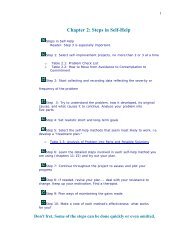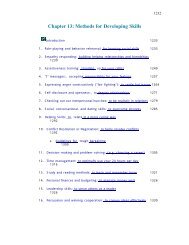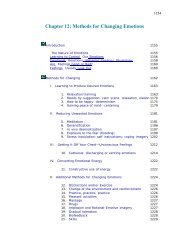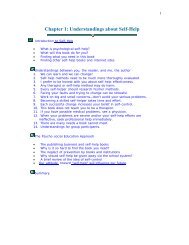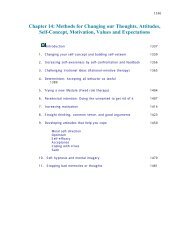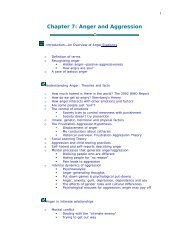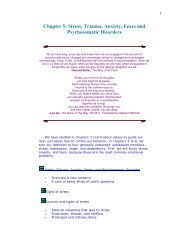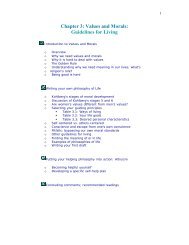Methods for Changing Behaviors - Psychological Self-Help
Methods for Changing Behaviors - Psychological Self-Help
Methods for Changing Behaviors - Psychological Self-Help
Create successful ePaper yourself
Turn your PDF publications into a flip-book with our unique Google optimized e-Paper software.
student to go to the library; getting there is the problem. The detailed<br />
steps involved in getting to the library may include (1) finding a friend<br />
who does or will go to the library regularly, (2) asking to study with<br />
this friend, and (3) rein<strong>for</strong>cing the friend <strong>for</strong> being a good study<br />
partner who rein<strong>for</strong>ces you (Brigham, 1982). Throughout this book we<br />
find that our behavior is a result of "the company we keep." We can<br />
change our friends and/or find different friends.<br />
STEP FOUR: Implementation intentions: Mental preparations<br />
that increase the effectiveness of environmental cues to<br />
prompt desired behavior.<br />
As discussed in chapter 2, goals are usually more helpful if they<br />
are (a) are very specific (time, place, and exact behavior) rather than<br />
vague, (b) are in the near future, not distant, (c) involve learning<br />
desired behaviors rather than evaluating of how well you are doing,<br />
and (d) lead to positive outcomes instead of reducing negative<br />
behaviors. Once the desired goals are in mind and committed to, i.e.<br />
you have "intentions," this step helps you turn them into actions.<br />
Rather than using self-instructions to guide yourself through to your<br />
goal (as described in the next method), this approach uses selfinstructions<br />
to strengthen the connections between specific<br />
environmental situations and specific desired/intentional behaviors.<br />
This is done by deciding in advance when there may be good<br />
opportunities to per<strong>for</strong>m the desired goal-directed behaviors. Then you<br />
give yourself instructions that prime the specific situation to elicit a<br />
specific response, e.g. "as soon as I get home this evening and change<br />
clothes, I will start to walk... jog... exercise... swim...". This<br />
emphasizes the positive goal behaviors while avoiding the competing<br />
old bad habits, distractions, and unwanted behaviors. This and the<br />
following few paragraphs are summaries of a well documented article<br />
by Gollwitzer (1999).<br />
Not all desired behaviors can be pre-planned at specific times and<br />
places. Suppose you want to tactfully mention to your husband that<br />
most of his pants are out of style and too tight. By having some<br />
thoughts earlier in the day ("pre-deciding") about commenting "let's<br />
look <strong>for</strong> some new pants <strong>for</strong> you, honey" while having a good time<br />
shopping together that afternoon, you make it much more likely that<br />
you will think of it at an appropriate time and do it in an effective way.<br />
To some extent in this method the burden of self-control is shifted<br />
from your conscious mind to an automatic perceptual process--now<br />
when the appropriate shopping situation arises, it reminds you to<br />
make the comment you have previously rehearsed.<br />
Likewise, implementation intentions can be designed to catch a<br />
fleeting opportunity. Examples could be: "when I see a black man, I'll<br />
be friendly, not suspicious" or "whenever I meet an old person...<br />
someone with a strong southern accent... a homeless person... an<br />
oriental person..., I'll try to avoid stereotyping them." "When someone<br />
makes a sexist or critical remark, I will question the validity of their<br />
1073



